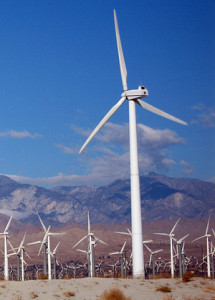Critics of wind power blame feds for killing, ‘chopping up’ eagles, other birds

By Tom Steward | Watchdog Minnesota Bureau
Wind industry insiders call it a “turbine collision,” though the feds prefer “non-purposeful take.”
But critics such as Sharon Klemm get real on the U.S. Fish and Wildlife website: “Why don’t you call it what it is? Shooting eagles. Killing Eagles. Murdering Eagles.”
The backlash over a controversial 2013 USFWS rule exempting wind farms from prosecution for the unintentional deaths of bald and golden eagles — for up to three decades — continues to play out in emotional online comments.
“Eagles along with other birds are being chopped out of the air and suffer horrible injuries and death by the blades of high-speed wind turbines,” wrote Patricia Lewko. “This practice has been given a green light by this administration in the name the name of Clean or Green Energy … What is so clean about chopping up birds to either lie in agony or be mutilated?”
Bald eagles were removed from the endangered species list in 2007, yet killing bald and golden eagles remains a felony punishable by a $250,000 fine and prison time.
“As the nation seeks to increase its production of domestic energy, wind energy developers and wildlife agencies have recognized a need for specific guidance to help make wind energy facilities compatible with eagle conservation and the laws and regulations that protect eagles,” according to the wind energy development section on the USFWS website.
In 2009, USFWS first instituted a permit system to allow exemptions from prosecution — for five years — for wind farms and certain other projects that inadvertently harm or kill eagles. Last year, the wildlife agency extended the duration of permits for “non-purposeful take of eagles” to 30 years, responding to pressure from the wind industry to provide more certainty for investors.
“The industry suffers a lot from uncertainty about policy of all sorts, environmental as well as tax policy, and a variety of things like that,” said Dan Turner, an analyst with Windustry, a Minneapolis renewable energy advocacy group. “It’s very hard to plan, especially these major projects that take multi-years, if you don’t know what the policy is going to be. It might just close you down.”
There’s no requirement to obtain the permit, but wind farms and other potential threats to eagles risk prosecution without one. Opponents will get the chance to discuss their concerns during five USFWS public meetings across the country to reconsider eagle-kill permits, starting this week in Sacramento and Minneapolis.
DYING IN THE WIND: Wind power proponents claim other sources kill far more eagles than turbines, but the USFWS is being sued by one environmental group that calls longer permits a “reckless and irresponsible gamble.”
“This is taking a look at what needs to be changed, what isn’t working, what still needs to be addressed,” said Margaret Rheude, a Twin Cities biologist and eagle expert for USFWS. “And so one of the big issues that we’re going to tackle is the permit duration, having the 30-year permits.”
USFWS models project that up to 1,100 bald eagles, excluding Alaska, could be killed annually without threatening the species, though experts say nowhere near that many actually die. Bald eagle populations in Minnesota and Wisconsin continue to flourish, but wind power critics from as far away as Green Bay, Wis., told Watchdog Minnesota Bureau they plan to make the trip and make their point.
“It’s quite a long drive but we think it’s important because Fish and Wildlife makes decisions that impact Wisconsin, too. This is the line in the sand,” said Sandy Johnson, a retired teacher from Green Bay Wisconsin. “ … For some reason, wind developers and their corporate owners are being given priority over the welfare of our raptors, and there are reports of cranes and songbirds and the bats being destroyed.”
Estimates vary widely on the collateral damage to eagles, bats and birds that tangle with wind turbines. A recent Wildlife Society survey estimated 1.4 million bat and bird fatalities annually, including 83,000 raptors. In the past five years, wind farms have destroyed at least 67 eagles, mostly golden eagles, according to a 2013 government report.
But the American Wind Energy Association claims turbines account for less than 2 percent of reported golden eagle deaths, and even fewer deaths of bald eagles. While declining to discuss the issue with Watchdog Minnesota Bureau, AWEA calls lead poisoning, vehicles and power lines greater threats.
“You could expect some deaths of eagles from wind turbines over the life of a wind farm, but the numbers are pretty small,” said Turner of Windustry. “There’s no threat to populations of eagles, certainly no species type threat, and if you compare other threats to them, it’s pretty insignificant.”
Yet several wind-friendly environmental groups also oppose the so-called eagle kill rule, which triggered a June 2014 lawsuit by the American Bird Conservancy.
“Giving wind companies a 30-year pass to kill Bald and Golden Eagles without knowing how it might affect their populations is a reckless and irresponsible gamble that millions of Americans are unwilling to take,” Dr. Michael Hutchins, national coordinator of ABC’s bird smart wind energy program, said in a release on the legal challenge.
Their shared concern for America’s national symbol puts some environmentalists on the same side as die-hard wind-power opponents hoping to modify or reverse the industry’s 30-year immunity.
“If the public shows up and raises enough ruckus over this so the bureaucrats in Washington see that we care, it’s really quite possible that they’re going to step back because of the politics of this,” said Mary Hartman, a Rochester activist whose group used the eagle issue to stop Minnesota wind farm last year. “If we don’t show up, then the wind industry is going to get what they want.”







